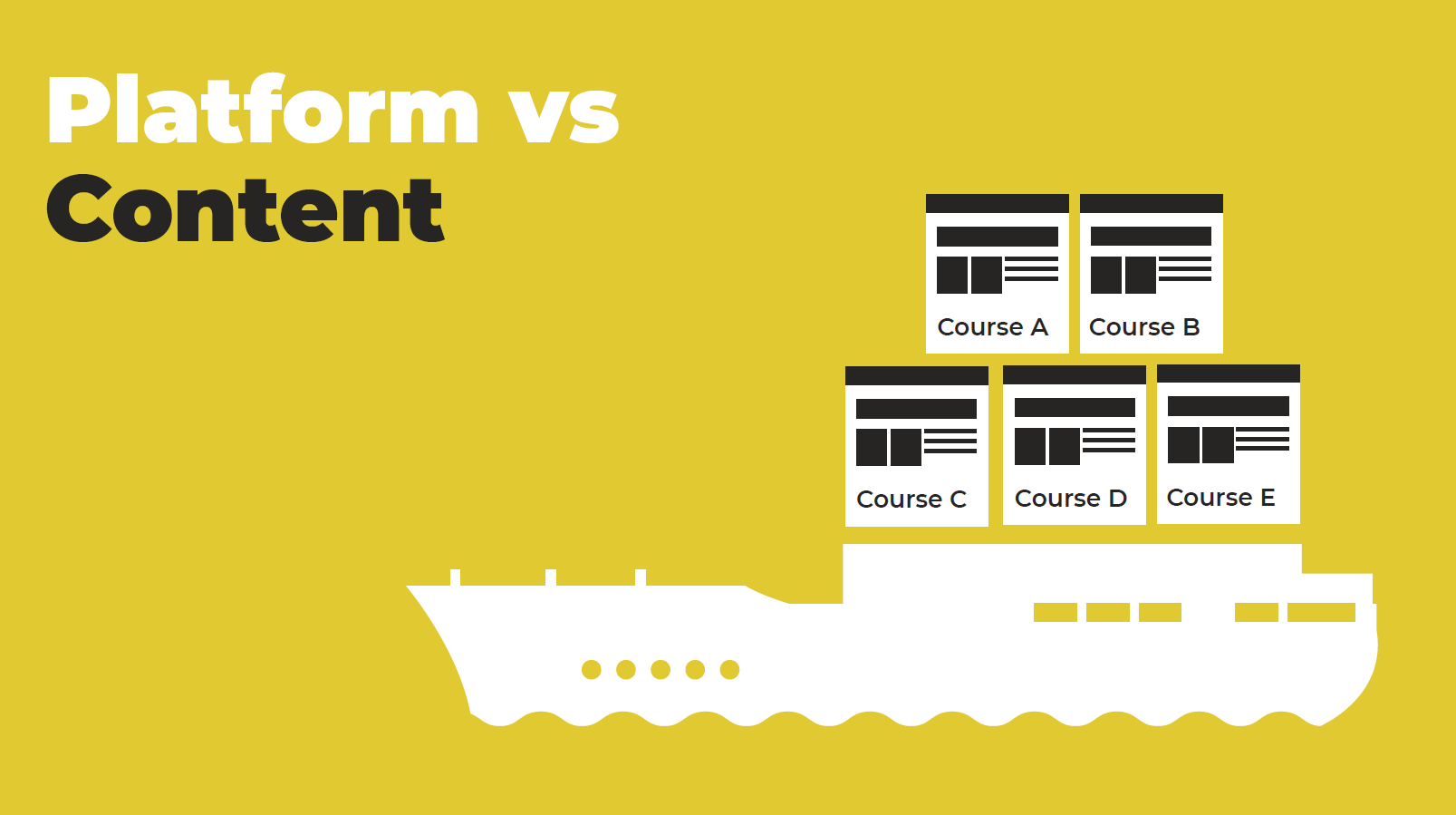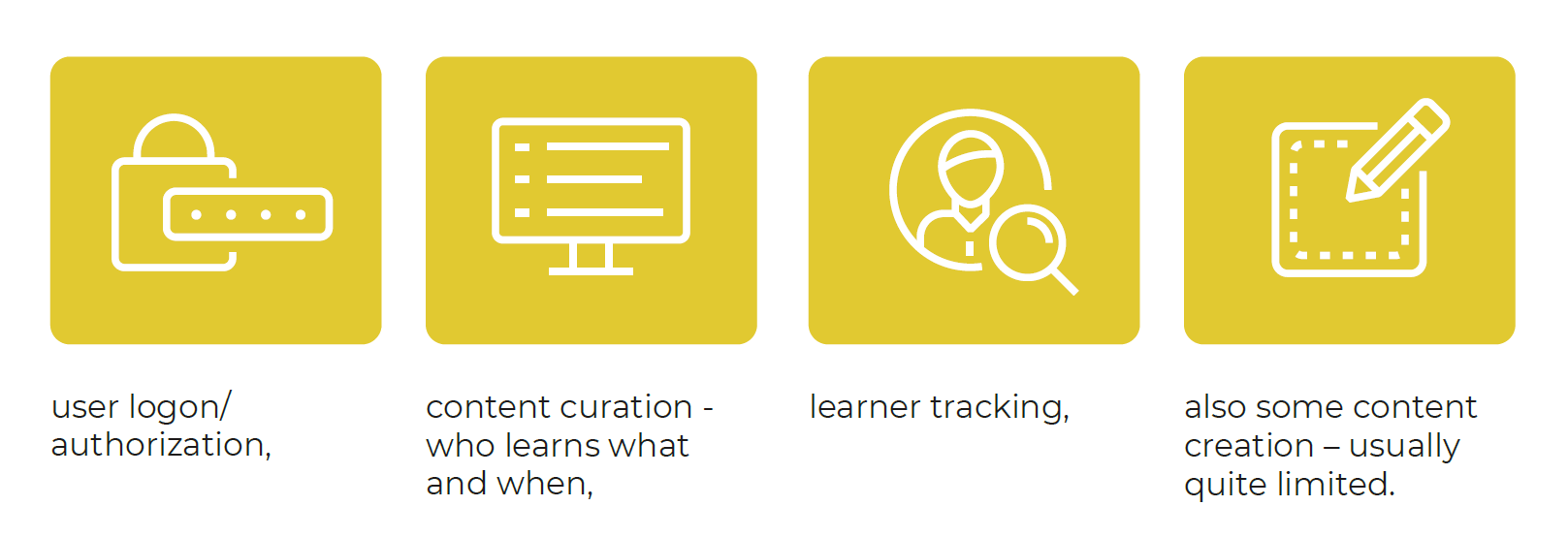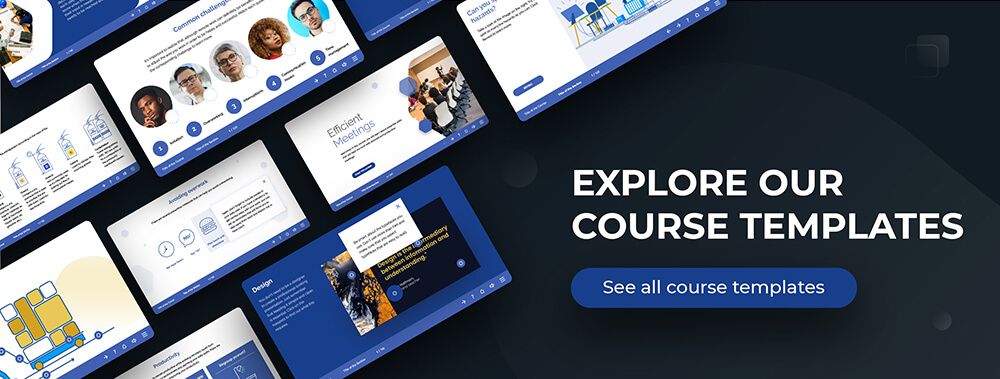This blog explains the core differences between an elearning platform and elearning content. What are they and how do they differ?
Both are core elements of elearning and you can’t have one without another. Of course, you can…but there is no point of that. 😉
At first, we are going to dive into the elearning platform and then explain more about the content.
This is part of our webinar “Elearning development 101” and you can learn more about the difference between elearning platform and content in this video.

The simplest explanation is a cargo ship. The platform is the ship and the content is cargo containers, carried by ship. Simple and easy! Ok, maybe not that simple and easy, but you get the idea! 😉
Let’s dive in to find out more!
Platform, LMS, LXP
As you can see from this subheading, “the ship” is known by many names. Some of the most popular are:
- LMS, meaning Learning Management System
- LXP, meaning Learning Experience System
- Platform, Elearning platform.
Various names, but the idea is the same – it is a virtual place all the elearning content is stored, used and interpreted.
Core functions
All of the different names normally ensure the following core procedures:

1. User authorization
It means that only authorised users can see the content stored inside the platform. Users also can have restricted access to the content.
2. Content curation
The content curation aspect shows who is learning what and when. Some of the platforms can suggest other courses for their learners based on the courses they have visited. Some give users access to new content after they have completed the required parts.
3. Tracking
This takes us to the next – tracking. In this instance, it is meant by progress tracking and shows the information about who has studied what, when and for how long. It can track either if the user has completed the course or left it in the middle. If the content is made as a test exercise, the platform can show how well the learner did in the test. It can show both if the learner passed or failed the test as well as the exact score.
Understandably, tracking part is the one with the loudest buzz around it. It is extremely important for compliance courses where every participant must be familiar with the information. Also, in general, it is informing and useful tool for management. Tracking allows to see employee progress as well as give insights about the content. It can show that maybe the test is too challenging as people can’t pass it or content is too dull and makes people quit early on.
4. Content creation
Some learning management systems have the option to create the content inside the program, so you wouldn’t have to purchase extra licenses for content creation tools. Even though it sounds like a good option, the content creation options are usually quite limited. You also have to keep in mind that if you change the learning management system there might be a chance that you will need to create them again in the other system, so most of the cases it’s better to create and store the content outside the LMS.
How does it work?
As you have figured by now, it all needs some magic (let’s call it engineering) to function like this. And this engineering magic is called compatibility standards. There are many, but the most popular are:
- SCORM
- xAPI
- cmi5
- AICC
We could write blocks and blocks of technical information, explaining the core differences between them. However, probably the simple point is enough – those standards are sets of information within the content put on the elearning platform. You’ll ask how does the information get to that content? I have the answer for you: the content needs to be published with tools who can apply the standards. By publishing elearning content in those tools (elearning authoring tools), you can define which standard to use. Then it creates a ZIP (compressed file folder) file. This file contains all the necessary information to communicate with the platform after the file upload.
Based on the standard and settings, different tracking options are available. Not all of the platforms share the same settings and requirements, same goes for the content creation tools. You need to dive in research to make sure your desired platform can understand and interpret the data exactly as you want. Same goes with your content creation tool – make sure you choose the right one so the content is viable within the platform of your choosing.
Content
Here comes the interesting part! If the platform is brains, content is visuals. It is all of the information meant for the learner – images, texts, PDFs, videos, courses, documents, … All the ways somebody can express knowledge and information.
Usually, it all starts plain and simple – with some good old PowerPoint presentations, PDF documentation and such. However, after a time it is clear that hundreds of pages of plain text or text and schemes can be rather a sad cluster of information.
Tracking info also reflects that user engagement in those materials.
Usually, somewhen around this time is the point management tries to make those materials more engaging.
And, oh boy, there are plenty of ways how to create engaging content!
Probably the fastest way is to use already pre-made templates for different types of pages and interactions. In this case, you only need to change the textual content and graphics to the ones you need. This helps to rather effortlessly create multiple courses with the same design and structure.
You can see some examples below – these are course templates we have created, based on our own template sets.
If the budget is friends with the imagination and designers, you can create some awesome custom stuff too. Those can be precisely tailored interactions with a spot on visualisations, games, created for this single instance and much more. Is all of the content equally interesting? Probably with the right budget and development team – yes! However, some types of content are more challenging than others.
Content types
There are two general types of content in elearning – compliance training and skill-building training.
Compliance training
Compliance training is a major part of elearning. It can be about various subjects – anti-money laundering, GDPR, food safety, hygiene and so on. The conjunctive element being – they all are obligatory training to comply with the legal requirements. It means sets of laws, rules, regulations and legal phrases. Sometimes the rules are firm and absolutely all of the legal terms needs to be on the front page and with all of the legal wordings. Other times, there can be compromises between legal requirements and user engagement in visually pleasing and easy readable courses.
Skill building
In general, skill-building courses are easier alterable and they have more space to stretch. By those, I mean all the soft skills, sales skills, improvement and educational courses. The content in this type of courses usually is more appreciative for engaging formats like games, simulations, VR’s and much more.
Conclusion
As you can see, both platform and content are inseparable. They work together to give a meaningful learning experience and data about the process. The platform keeps care of storing the content and giving access to it to whom needed, as well as follows their journey and gives out information about process and results. The content is the materials learners are dealing with. By investing time and imagination, those materials can become amazing stories, captivating learners.
Continue next
Next you can learn what’s important to know when creating an elearning course and what are the next steps in the process in our blog post – How to Create Elearning Content. There you will learn more about what you need to know before you start creating content and why it’s important to have measurable goals.



Comments